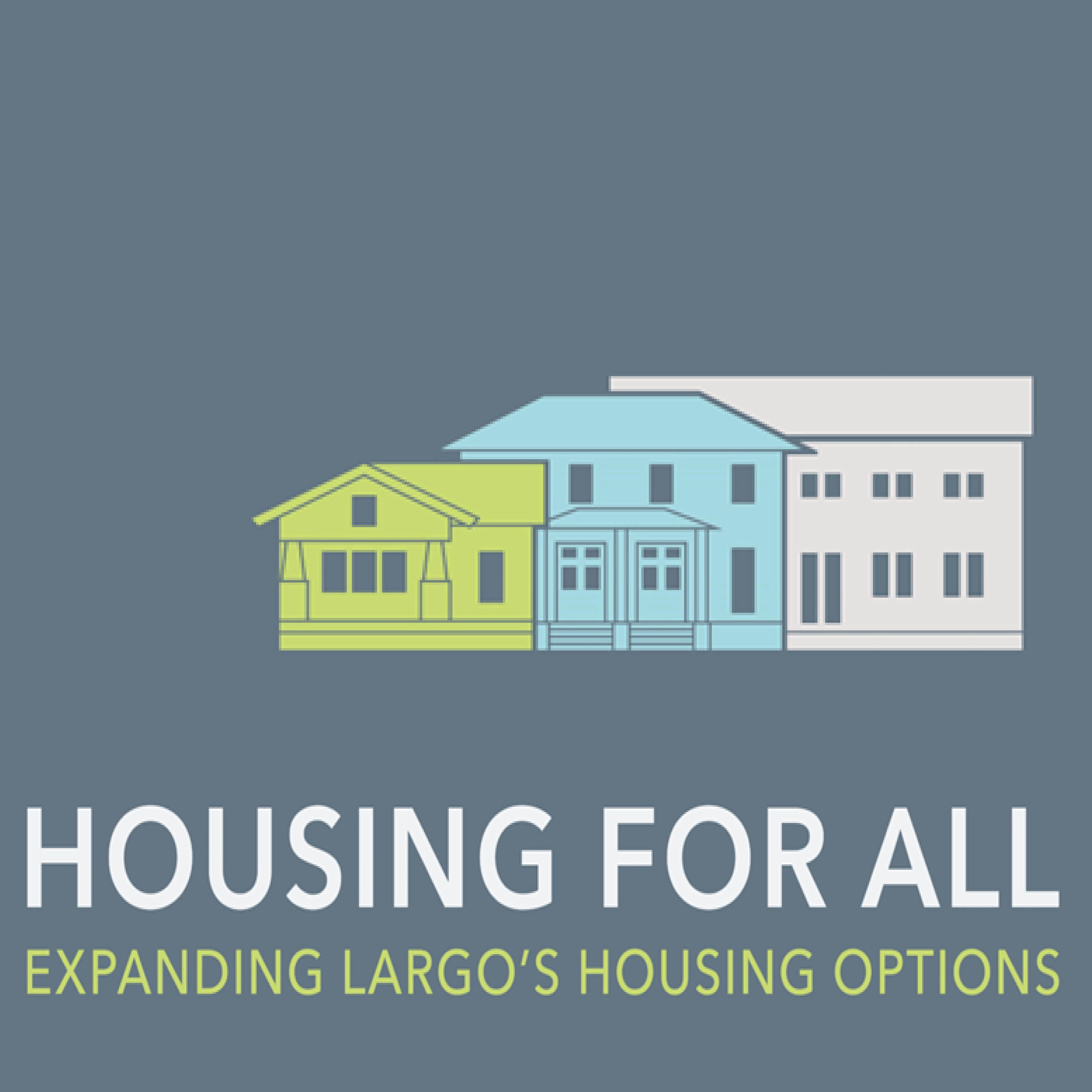
Select by Location:
|
Coastal Southwest Florida
In the wake of Hurricane Ian, the Coastal Florida
Recovery and Resiliency Partnership
provided technical assistance to the City of Fort Myers,
the Town of Fort Myers Beach, and the
City of Sanibel on projects selected by each community. In 2024, Spikowski Planning and Dover,
Kohl and Partners assisted the Horlsley Witten Group,
staff and officials from the three communities, and the
sponsoring state and federal agencies.
Details are available by clicking the
SEE DETAILS button.
Largo, FL
The City of Largo (FL) undertook
an initiative in 2023-24 to encourage a wider variety
of housing types throughout the city. Especially
with rising costs, city policies and standards
must ensure the housing supply meets the needs of
all households and supports a high quality of life.
Spikowski Planning assisted Partners for Economic Solutions,
Dover, Kohl and Partners, and city staff in this initiative.
The final phase of this initiative will be completed in late 2024.
For details, click the SEE DETAILS button.
Lee & Collier County, FL
The Lee County (FL) Metropolitan Planning Organization evaluated the feasibility
of a multi-use trail in the Seminole Gulf Railway corridor south of Alico Road.
Additional sponsors include the Village of Estero and the City of Bonita Springs.
This 2022-23 feasibility study was the culmination of nearly a decade of planning for potential future
uses that could co-exist with freight rail in this corridor.
Spikowski Planning assisted Volkert and other consulting firms in this study.
For details, click the SEE DETAILS button.
Punta Gorda, FL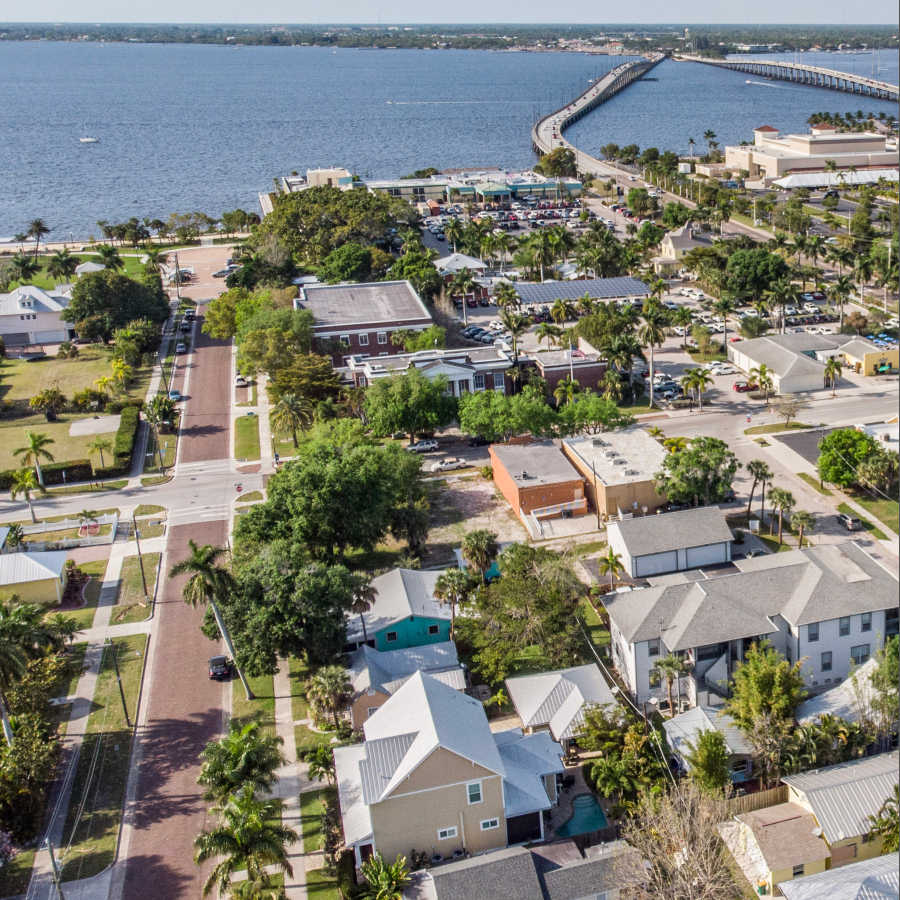
The City of Punta Gorda (FL) updated its 2005 Citywside Master Plan in 2019.
Punta Gorda's small fishing village charm remains a key part its identity, despite the shift toward retirees and tourism.
The master plan update balanced longstanding community goals with the desire for a vibrant and economically sustainable future.
Spikowski Planning assisted Dover, Kohl & Partners in implementing this plan. Adoption of code amendments took place in the fall of 2023.
For details, click the SEE DETAILS button.
Neptune Beach, FL
The City of Neptune Beach (FL) sponsored a Vision Plan in 2020
to determine how Neptune Beach should evolve and where the City should prioritize investments.
Initial outcomes of the Vision Plan included revisions to the city's comprehensive plan and
land development regulations.
Spikowski Planning assisted Dover, Kohl & Partners on these revisions.
Details on the Vision Plan and the subsequent revisions are available
by clicking the SEE DETAILS button.
Martin County, FL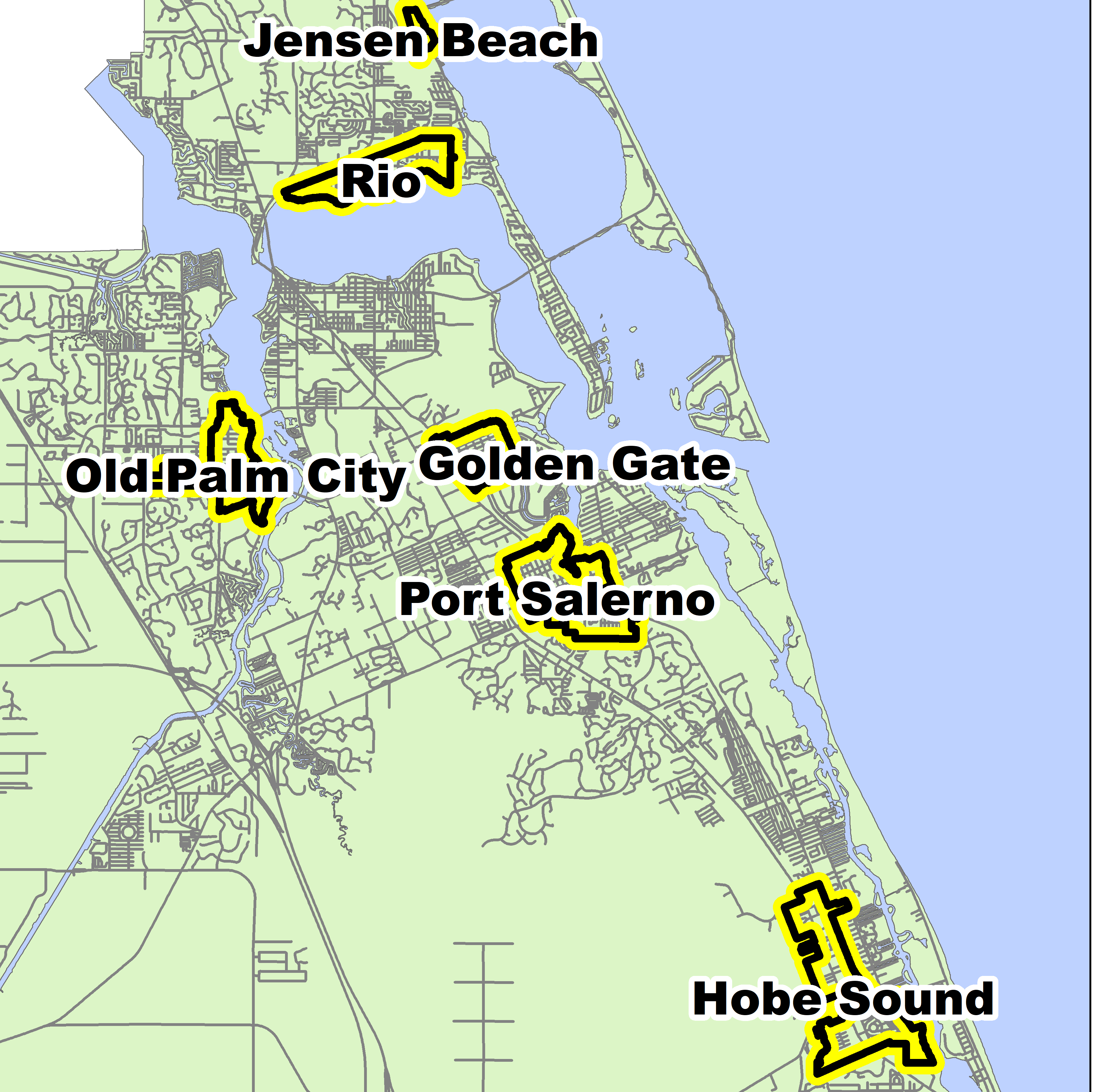
Martin County (FL) has six Community Redevelopment Areas (CRA), each with
special land development regulations: Jensen Beach, Rio, Old Palm City, Hobe Sound, Port Salerno, and Golden Gate.
County officials recently updated all of those regulations.
Spikowski Planning assisted the Treasure Coast
Regional Planning Council and county staff in preparing the code updates and related comprehensive plan updates.
General provisions for all six codes, and the specifics for each,
are available by clicking the SEE DETAILS button.
AARP
A mission of the AARP is empowering people to chose how they live as they age, which
includes advocacy for multigenerational housing, accessory dwellings, multiple units
in homes, missing-middle housing, and housing in walkable areas.
Bill Spikowski and other faculty in the Project for Code Reform assist the AARP
by conducting mini code audits across the country to identify regulatory barriers to these housing options.
Details are available by clicking the SEE DETAILS button.
North Palm Beach, FL
The Village of North Palm Beach
(FL) adopted a Citizens Master Plan in 2017. A major recommendation
was to update the Village's codes to authorize and
encourage redevelopment that would implement the Master Plan.
A major code update for commercial and mixed-use development began in 2018; Spikowski Planning
worked with Dover, Kohl & Partners on that update. The updates were adopted
in September 2020; details are available by clicking the SEE DETAILS button.
Project for Code Reform
Barriers to creating compact walkable communities often include zoning provisions that make it illegal
to create or upgrade these communities.
The Congress for the New Urbanism has launched the Project for Code Reform to
provide communities with place-specific reforms
that address their most problematic code barriers.
Bill Spikowski serves as a faculty member for the Project for Code Reform.
Details are available by clicking the SEE DETAILS button.
Collier County, FL
The Collier MPO (Collier County FL) updated
the previous (year 2040) Long-Range Transportation Plan (LRTP)
to a new planning horizon year of 2045. Spikowski Planning
assisted Jacobs Engineering and Collier MPO staff
in this effort, primarily by creating two detailed land-use scenarions
for Collier County for the year 2045 so that travel needs can
be simulated for each scenario. This revised LRTP was adopted in December 2020.
Building Types
Despite the diverse palette of buildings found in our most beloved neighborhoods,
zoning codes typically use a blunt system
that regulates buildings by their current uses and setbacks.
A coding technique found in some form-based codes
applies pre-defined “building types” to enable a finer-grained mix of
“missing middle” housing types. Bill Spikowski and Tony Perez recently published a
guide on how to use building types in zoning.
Fort Myers, FL
Fort Myers (FL) recently adopted a major revision to the Transportation Element
of its Comprehensive Plan. Spikowski Planning Associates was retained by city officials
to prepare these amendments, which affected Complete Streets, downtown mobility,
redevelopment planning, traffic calming, bike/ped plans, and long-range
transportation improvements. The amendments were adopted in November 2019.
Lake Park, FL
Since the mid-1990s, the Town of Lake Park
(FL) has coordinated its regulations for the former Twin City Mall site with the
Village of North Palm Beach; the site is bisected by their municipal boundary.
The Town is updating its redevelopment regulations for the site in coordination with a matching
effort in the Village. Spikowski Planning has been working with Dover, Kohl & Partners
on the new regulations. Code details will be available soon by clicking the SEE DETAILS button.
Fort Myers Beach, FL
The former Helmerich Plaza at
Fort Myers Beach (FL) occupied a prime location
in the block between Estero Boulevard, Crescent
Street, and Fifth Avenue. In 2017, the Town
Council hired Spikowski Planning to assist in the review
of a redevelopment project later known as Margaritaville
Resort. A staff report was prepared by Spikowski Planning
to summarize the proposal and advise the Local Planning Agency
and Town Council how they might proceed.
Palmetto Bay, FL
Palmetto Bay (FL) is located along the Atlantic Ocean south of Miami.
Its Downtown Urban Village code
is designed to lead to a new downtown centered on the
Village's civic complex which is near two stations on the busway.
Spikowski Planning has been involved with drafting major revisions to this code,
which were presented at a public workshop in July 2018.
Delray Beach, FL
The Treasure Coast Regional Planning Council prepared a new code for the central business district in Delray Beach (FL).
Delray Beach is a vibrant cosmopolitan city between West Palm Beach and Fort Lauderdale.
This form-based code covers downtown Delray Beach, including a proposed Tri-Rail commuter rail station
and adjoining neighborhoods to the west and east.
Spikowski Planning Associates assisted the council and city officials in preparing this code.
Hillsborough County, FL
Little Manatee South is on the east shore of
Tampa Bay from the Little Manatee River to the Hillsborough County (FL)
line. The planning area is rural with extensive
preserves and submerged lands. Spikowski
Planning was retained to provide recommendations
for future growth and preservation, with
particular attention to the fiscal implications
of growth beyond the Urban Service Area and the
use of form-based techniques to ensure compact
development patterns.
Lee County, FL
A rail corridor feasibility study was commissioned by
the Lee County (FL) Metropolitan Planning
Organization to assess potential public uses of a
freight rail corridor that runs through central
Lee County. The corridor is owned by CSX and
leased to Seminole Gulf Railway. Potential uses
include expanded freight capabilities, public
transit, and multi-use trails. Spikowski Planning
is a subconsultant to David Plummer & Associates,
along with HDR and David Douglas & Associates.
Fort Myers, FL
Fort Myers (FL) adopted a local historic preservation ordinance in mid-1990s and designated four historic districts.
In 2016, city officials began a major update to the regulations that govern historically designated districts and properties.
Spikowski Planning Associates assisted Parker/Mudgett/Smith Architects in improving the city's historic preservation regulations, which were adopted in March 2019.
Fort Myers, FL
Fort Myers (FL) is the central location for junkyards and recycling businesses in Lee County.
Regrettably, some of these businesses are located in residential areas or in full view from major roads.
City officials retained Spikowski Planning Associates to conduct a comprehensive analysis
of the technical and policies issues surrounding these business and then prepare a new
regulatory approach for the city's land development code.
Fort Myers, FL
Fort Myers (FL) is home to the largest concentration of used car dealers in Lee County.
In 2017, city officials retained Spikowski Planning Associates to examine city rules for these businesses,
citing their dismal appearance and geographic concentration,
and to prepare a better regulatory approach for the city's land development code.
El Paso, TX
Spikowski Planning prepared the regional land use
patterns element for a new comprehensive plan for
El Paso (TX). A new future land use map
replaced the previous map’s zoning-like
designations with growth and open-space sectors.
The new map guides city decisions on annexations,
impact fees, and utility expansions. A series of
overlays defines key generators of movement and
economic activity, plus prime locations for
development and redevelopment.
El Paso, TX
Spikowski Planning assisted lead consultant Dover,
Kohl & Partners in preparing an update for the
Thoroughfare Plan forEl Paso (TX). This plan
illustrates a regional thoroughfare network for
the entire county, implementing the city
comprehensive plan's distinction between compact
urban and drivable suburban contexts. The plan
expands the collector and minor arterial network
and sidesteps the hurdles caused by the
conventional arterial/collector/ local
classification system.
Hillsborough County, FL
The Hillsborough County Planning Commission (FL) engaged
Spikowski Planning and Dover Kohl to improve how their comprehensive
plans discourage strip commercial and encourage
mixed-use development. This effort identified
national best practices plus methods used in
other comp plans to address these challenges.
The final report proposes a policy approach for
updating the comprehensive plans for Tampa,
Temple Terrace, Plant City, and the
unincorporated county.
Lee County, FL Three
land use scenarios for the year 2040 were
evaluated by the Lee County
(FL) Metropolitan Planning Organization for their potential to reduce trip
lengths and increase transit viability.
In June 2014, the MPO board selected a preferred
scenario as the basis for the upcoming long-range
transportation plan. Spikowski Planning and
Criterion Planners worked with Jacobs
Engineering and city/county planners to
formulate and analyze the scenarios.
Cocoa Beach, FL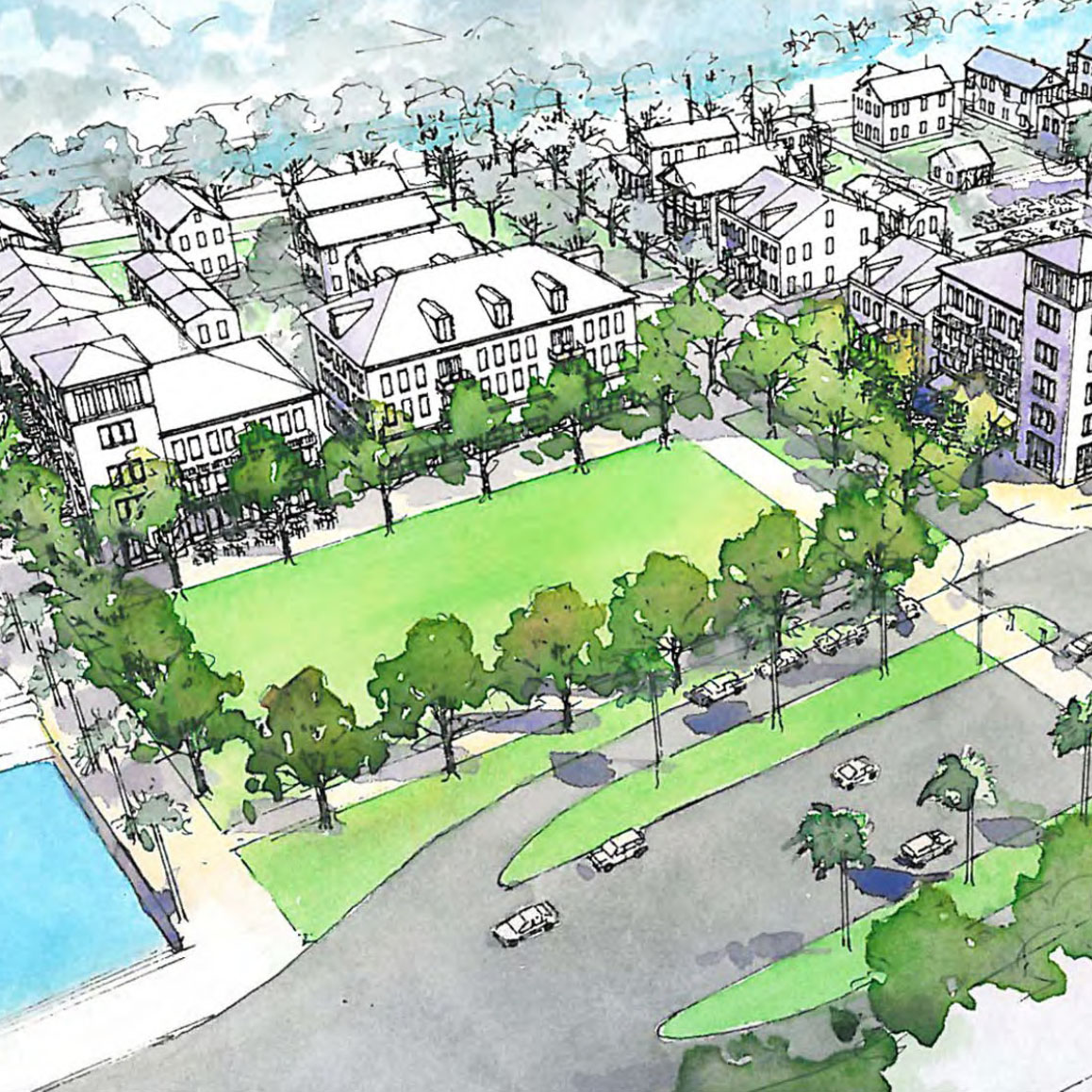
The City of Cocoa Beach (FL) sought a
cohesive vision for the commercial properties north of
downtown Cocoa Beach.
The resulting redevelopment plan was intended to spark desirable
private development that will upgrade the city's primary tourism areas
while retaining the small-town character of Cocoa Beach.
Spikowski Planning created implementation strategies to permit the desired
form of future development and later draft revisions to the city's land
development code.
Estero, FL
Estero is located in Lee County (FL) between the cities of
Fort Myers and Bonita Springs. Spikowski Planning assisted Seth Harry & Associates
in conceptual planning for future mixed-use development in Estero on behalf
of the Estero Council of Community Leaders. The final proposals included
compact, walkable, higher-density neighborhoods in a mixed-use Village Center
and a separate Healthcare Village, both offering convenient access to shopping,
entertainment, and services.
Hallandale Beach, FL
Hallandale Beach is a thriving coastal community mid-way between the cities of Fort Lauderdale and Miami. Spikowski Planning assisted the Treasure Coast Regional Planning Council and city staff in creating new codes for two designated Regional Activity Centers (RAC) in Hallandale Beach. The Central RAC code is a form-based code centered on the existing civic complex and a proposed Tri-Rail commuter rail station; the West RAC code is a conventional zoning code.
Southeast Florida Community indicators can measure
progress toward policy goals in fields such as transportation or quality of life.
Spikowski Planning prepared this report, “Indicators and Benchmarks in Successful
Regional Visions and Plans,” for the Seven50 Plan for Southeast
Florida Prosperity, a plan for seven counties over 50 years.
This report examines indicators and benchmarks that have been used around
the country, either separately or as part of regional visioning efforts.
Fort Myers, FL
Disaster-related redevelopment planning helps
communities organize their long-term disaster
recovery strategies so they can recover more
efficiently, maintain local control over the
recovery process, and build back better. Spikowski
Planning was retained by the City of Fort Myers
(FL) in 2012 to update its disaster-related
redevelopment policies and upgrade other
comprehensive plan provisions concerning hurricane
evacuation and emergency shelter issues.
Fort Myers, FL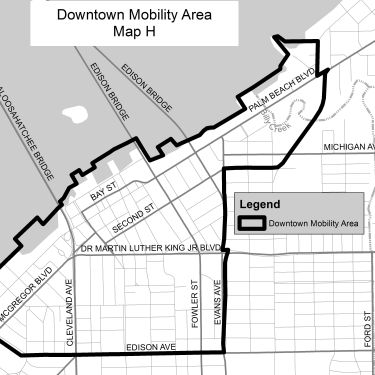
Downtown Fort Myers is the historic center
of Lee County (FL) and home to major civic and
government activities. To support its
revitalization, the city government wished to
improve mobility downtown by emphasizing alternate
modes of travel, including improved transit, bike
and pedestrian facilities, and land-use strategies
that support these modes. Spikowski Planning
assisted David Plummer & Associates in creating a
Downtown Fort Myers Mobility Plan in 2012
and 2013.
Southeast Florida
Seven50 ("seven counties, 50 years") is a
blueprint for prosperity for six million residents
in Monroe, Miami- Dade, Broward, Palm Beach,
Martin, St. Lucie and Indian River counties.
Seven50 is spearheaded by the South Florida and
Treasure Coast Regional Planning Councils and the
Southeast Florida Regional Partnership, a
collaboration of 200 public, private, and civic
stakeholders. Spikowski Planning is assisting
Dover, Kohl & Partners in preparing the Seven50
plan.
Lee County, FL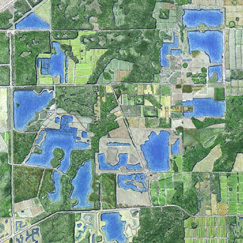
Lee County (FL) applied a Density Reduction
/ Groundwater Resource designation to its
southeast quadrant to protect the area’s shallow
aquifers. These 83,000 acres also have farms,
rural neighborhoods, limerock mines, and
endangered-species habitat. Spikowski Planning was
the chief local subconsultant to a national
planning team that formulated land-use
scenarios, analyzed long-term demand for rock,
updated the comprehensive plan, and wrote a
form-based code.
Longboat Key, FL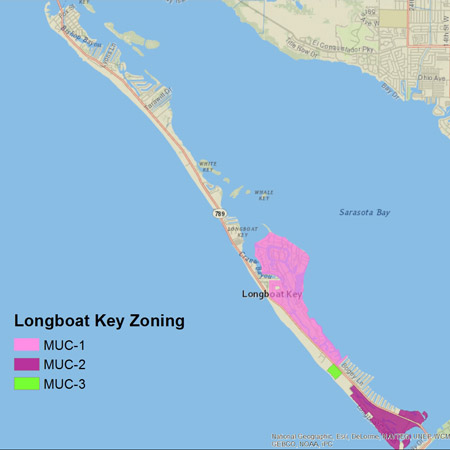
Longboat Key is an elegant resort community on
a fragile barrier island in western Sarasota
County (FL). Spikowski Planning redrafted
portions of the Town’s zoning code to add
standards in response to court decisions that
concluded the Town Commission had delegated too
much discretionary authority to itself to the quasi-judicial
zoning process. The code revisions also create a
procedure for allocating new tourist development
rights approved in a referendum of Longboat Key
residents.
Fort Myers Beach, FL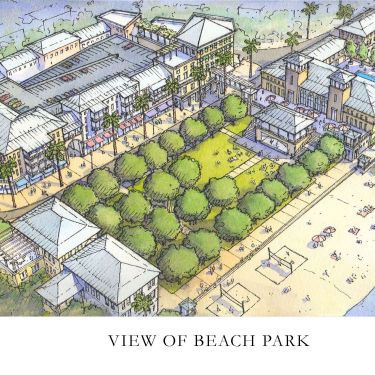 In
2005, the Town of Fort Myers Beach (FL)
retained Spikowski Planning to evaluate the 1999
comprehensive plan, which is a periodic
requirement of Florida law. This evaluation
focused on improving Estero Boulevard for all
users, creating a beachfront park and additional
shared parking, adjusting the town’s "buildback"
rules for older nonconforming buildings, and
reconsidering the value of the town’s many motels
which at the time were being converted to
condominiums.
Fort Myers, FL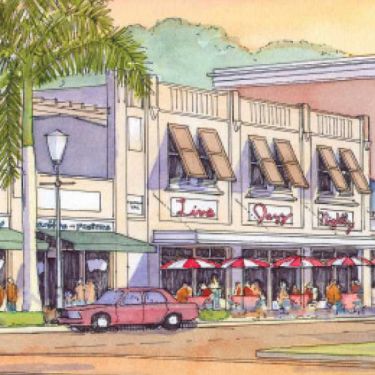 A
revitalization plan was created in 2006 for two
major corridors that bisect the Dunbar
community in Fort Myers (FL). This plan
focused on physical improvements that would create
complete walkable neighborhoods for
this proud community. The plan also included
critical regulatory changes and detailed
strategies for implementation. Spikowski Planning,
Lee Duffus, and Hall Planning & Engineering
assisted Dover, Kohl & Partners in creating this
plan.
Fort Myers, FL East
Fort Myers is a historic multi-ethnic community
located midway between downtown Fort Myers
(FL) and I-75 with two waterfront boundaries.
Spikowski Planning and Lee Duffus assisted Dover,
Kohl & Partners in creating an East Fort Myers
Revitalization and Redevelopment Plan in 2010.
The plan’s strategies included enhancing distinct
neighborhoods; building more – but making it good;
transforming Palm Beach Boulevard; and connecting
the green spaces.
St. Lucie County, FL
Spikowski Planning was chief code-writer for a
plan to maintain farming in 28 square miles in
St. Lucie County (FL) just beyond the urban
fringe of Fort Pierce by transferring development
rights to new towns and villages. This form-based
code implemented a Towns, Villages and
Countryside regional plan prepared by the
Treasure Coast Regional Planning Council. Prior to
this plan and code, one-acre lots were the default
pattern, a density that is neither urban nor
rural.
Fort Myers Beach, FLAfter
the new Town of Fort Myers Beach
(FL) created its own Comprehensive Plan, a new Land Development Code
was needed to implement the plan. In 2001, the
town retained Spikowski Planning to create this
code, which includes zoning and subdivision
regulations, a property maintenance code,
floodplain regulations, marine and natural
resource standards, a historic preservation
program, and standards for waterfront properties
facing the beach, bay, and canals.
Fort Myers Beach, FL After residents of the
Town of Fort Myers Beach (FL)
incorporated and created its own Comprehensive
Plan, a new Land Development Code was needed to
implement the plan. In 2001, the town retained
Spikowski Planning to create this code. The
complete archives of the code development
process remain on-line, including early drafts
of each chapter, summaries of public
participation, details of the adoption process,
and prior amendments to the code.
Sarasota County, FL In
2001 Sarasota County (FL) adopted a 50-year
vision for redevelopment at key locations in its
urban areas. A new zoning code was then adopted to
incentivize redevelopment; however, the code was
overly rigid and remained unused. Spikowski
Planning and Dover Kohl were retained by the
county to add more flexibility. A new form-based
code was created for developers willing to allow
early input from other stakeholders including
nearby residents and county staff.
Fort Myers Beach, FL
Residents created the Town of Fort Myers Beach
(FL) in 1995 to take control of land-use decisions
from Lee County. Spikowski Planning was the lead
consultant for a participatory process that
produced an entirely new comprehensive plan. The
plan revolved around a community design element
that allowed the plan to bridge a major gap
between the economic interests of its tourist
economy and the many local residents who fervently
opposed any further development.
Fort Myers Beach, FL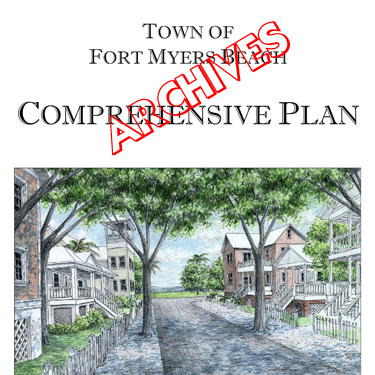 Residents created the
Town of Fort Myers Beach (FL) in 1995 to take control
of land-use decisions from Lee County. Spikowski Planning was the lead
consultant in preparing an entirely new comprehensive plan. The complete
archives of the comprehensive planning process remain on-line, including
early drafts of each element, summaries of public participation, details
of the adoption process, and amendments to the plan up until the 2005
evaluation and appraisal report.
Upper Captiva, FL The
Upper Captiva Community Panel has prepared
a plan to preserve the character, scale, fragile
environment, and way of life for residents and
visitors to th this bridgeless barrier island in
western Lee County (FL). Spikowski Planning is
assisting Florida Gulf Coast University in
drafting implementing codes that address low-speed
electric vehicles on pathways, removal of invasive
exotic vegetation from the island, and limiting
outdoor lighting to maintain dark skies.
Greater Pine Island, FL
Spikowski Planning was the lead consultant to the
Greater Pine Island Civic Association to
protect a coastal community with a single access
road and surrounded by aquatic preserves. Pine
Island, in Lee County (FL), has few beaches or city services and limited
employment, yet remains an affordable coastal
community. The new plan limited development on
farmland and phased growth to match road capacity.
Spikowski Planning later drafted zoning
regulations to implement the plan.
El Paso, TX El
Paso (TX) is building four bus rapid transit
lines, supported by street improvements near
stations to support compact mixed-use development.
"Connecting El Paso" also focuses on downtown and
other areas that can become new centers of El
Paso, including redeveloping an abandoned smelter
site, the largest undeveloped site near downtown.
Spikowski Planning assisted lead consultant Dover,
Kohl & Partners with transect assignments downtown
and around major transfer centers.
Lehigh Acres, FL
Lehigh Acres in eastern Lee County (FL) is one
of the largest 1950s-era antiquated subdivisions
in Florida, with about 120,000 single-family lots.
Spikowski Planning was the lead consultant for the
Lehigh Acres Commercial Land Use Study
which identified strategies to counteract mistakes
of the original developer, which had reserved
little land for businesses or other housing
types. Corrective links were identified to repair
critical discontinuities in the street network.
Lehigh Acres, FL To
encourage healthy commercial redevelopment in
Lehigh Acres (FL), Spikowski Planning was
retained by the community redevelopment agency to
illustrate a variety of approaches to improving
the storefronts of existing commercial buildings.
Traditional local styles of architecture were used
to illustrate design themes that would be would be
equally appropriate to new buildings. Team Plan
Inc. from North Palm Beach was the design
subconsultant.
Lehigh Acres, FL
Veterans Park, now the largest community park in
Lehigh Acres (FL), was landlocked when the
only adjoining unplatted tract became available in
1995. Lee County was collecting impact fees to
build new parks and libraries but expected
unincorporated communities like Lehigh Acres to
fund all operations. Spikowski Planning was
retained by the community redevelopment agency for
Lehigh Acres to assess the tract, prepare a
preliminary site plan, and identify funding
options.
Lee County, FL
Reconnecting Lee County is an informal association
that supports transit-oriented development, major
improvements to public transportation, and
sensible responses to the vast antiquated
subdivisions in Lee County (FL). Bill
Spikowski was a co-founder of Reconnecting Lee
County with Mike Ciccarone, Charles Bigelow, and
Brian Bigelow. Reconnecting Lee County educates
its members and the public through symposia and
public policy advocacy.
Fort Myers Beach, FL The
Town of Fort Myers Beach (FL) retained
Spikowski Planning to revise its zoning code to
implement its 1999 Comprehensive Plan. The new
code, adopted in 2003, combines conventional
zoning districts for stable neighborhoods with
form-based zoning districts for redevelopment
areas. All zoning districts use a streamlined
method of assigning land uses. The new code is
administered by town staff, replacing a cumbersome
public hearing process for most applications.
Fort Myers Beach, FL
Seafarer’s Mall was once the hub of tourism at
Fort Myers Beach (FL), with a prime location
in the block between Estero Boulevard, Crescent
Street, and Fifth Avenue. In 2002, the Town
Council approved a development agreement for a
larger entertainment complex and shared parking
facility that would be known as Seafarer's Plaza.
Spikowski Planning was retained by the town to
negotiate this agreement on behalf of the town.
Lee County, FL Planning for rural areas often
starts and ends with requiring large lots and putting off further planning
until growth pressures become overwhelming. The Estero Community Improvement
Foundation retained Spikowski Planning to prepare a report, Toward a Greener
Lee: Effective Planning Alternatives for Rural Lee County, that formulated
critical planning questions for rural southeast Lee County (FL).
This report examined rural planning efforts in four other coastal Florida
counties.
Fort Myers Beach, FL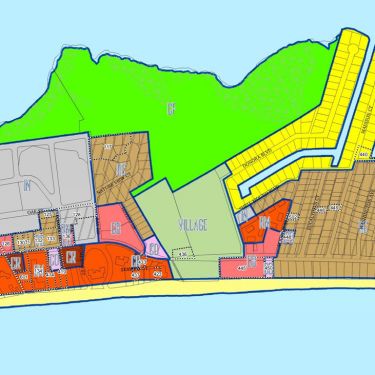 After
forty years of zoning administered by Lee County
(FL), the Town of Fort Myers Beach retained
Spikowski Planning in 2004 to create a entirely
new zoning map to accompany the new Land
Development Code. This map contains conventional
zoning districts for its stable neighborhoods,
form-based zoning districts for its redevelopment
areas. Obsolete zoning actions
were transferred to a separate "historic" zoning
map for reference purposes.
Fort Myers Beach, FL In
2006, FEMA released preliminary flood insurance
rate maps that would replace maps
that had regulated development at Fort Myers
Beach (FL). The new maps would have precluded
sidewalk-level commercial uses in much of the
town’s pedestrian core. Spikowski Planning, the
town’s general planning consultant, commissioned
Tomasello Consulting Engineers to peer-review
FEMA’s models. Once all errors were corrected, the
revised maps were far less damaging to downtown.
Cape Coral, FL In
just five decades, Cape Coral (FL) has gone
from uninhabited to one of the largest cities in
Florida. Yet much of downtown is still single-story buildings in
strip
format. Spikowski Planning assisted Dover, Kohl &
Partners in preparing Design Downtown, a
2002 CRA master plan for downtown Cape Coral (FL),
and a form-based code to implement that plan. A
later plan for downtown Cape Coral, the South
Cape Vision Plan, was prepared by Zyscovich
Architects in 2011.
Form-Based Codes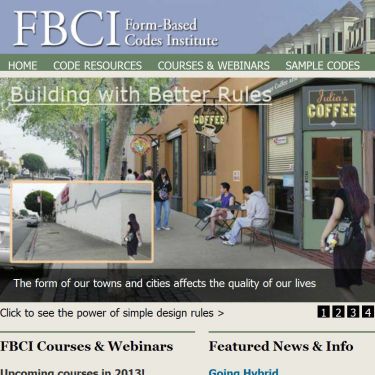 The
Form-Based Codes Institute (FBCI) is a
think-tank that develops standards for
form-based codes, a type of zoning that can
achieve community visions based on time-tested
forms of urbanism. FBCI promotes the widespread
adoption of effective codes, develops
standards, and educates public officials and
professionals on coding principles and practice.
Bill Spikowski is a founding board member of FBCI
and has taught every level of code courses
the institute offers.
Southwest Florida In
1994, Bill Spikowski wrote Farmworkers in Lee
County: The Housing Challenge to identify
housing needs of migrant farmworkers. This study
was instrumental in the formation of the
non-profit group Partnership in Housing, Inc.
This group used the study’s findings to obtain
federal grants to construct Pueblo Bonito, 130
units of affordable housing for families in Bonita
Springs (FL). The first phase is shown above.
Fort Myers, FL
Florida’s Great Recession scuttled many of the
high-rises proposed for the waterfront in downtown
Fort Myers (FL). Six redevelopment parcels
surrounding Centennial Park suddenly became
available and could be used to expand this
riverfront jewel for a small fraction of their
cost just several years earlier. Centennial Park
is a busy venue for political, entertainment, and
religious gatherings, as well as a daily
playground for city residents and host to a weekly
farmer’s market.
Fort Myers, FL The
downtown redevelopment agency in Fort Myers
(FL) retained the Miami planning firm Duany
Plater-Zyberk & Co. to update a 1986 downtown
master plan. The new 2003 plan was based on the
principles of New Urbanism, focused on pedestrian
connectivity to the built environment, streetscape
improvements, increased residential densities, and
restoration of the historic structures. This plan
was updated in 2010 by Acquest Realty Advisors.
New Urbanism in Florida In 2005,
A Guidebook to New Urbanism in
Florida was published to update an
earlier edition and to commemorate and celebrate
the rich variety and geographic extent of
Florida’s New Urbanism. The 2005 Guidebook
reflected the rising influence of New Urbanism
over public policy and private investments in
Florida’s designed environment. Bill Spikowski
served on the editorial committee for the
publisher, the Florida chapter of the Congress
for the New Urbanism.
Collier County, FL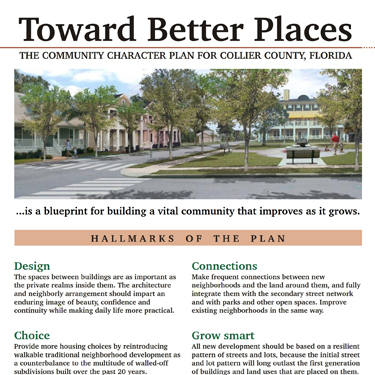 The Community Character Plan for
Collier County (FL) integrates
planning at the front lines of battles over
sprawl, traffic, ecology, and equity. The
public realm is defined as not only streets and
urban open spaces but also systems of habitat, waterflow, and traditional
rural patterns. Examples are provided to retrofit
introverted subdivisions and transform
arterials into great streets. Spikowski Planning
assisted Dover, Kohl & Partners on this
plan.
Collier County, FL Naples Park, in
northern Collier County (FL), is an affordable
enclave in a wealthy coastal county. Spikowski
Planning assisted Dover, Kohl & Partners in
drafting The Naples Park Community Plan in 2003.
Although never adopted by Collier County, this
plan proposes solutions for chronic flooding,
missing street trees, grossly inadequate
sidewalks, improved integration of businesses
and neighborhoods, and introducing small
neighborhood parks.
Lee County, FL BikeWalkLee is a community
coalition raising public awareness and
advocating for complete streets in Lee
County (FL) -- streets that are
designed, built, operated, and maintained for
safe and convenient travel for all users:
pedestrians, bicyclists, motorists, and transit
riders of all ages and abilities. BikeWalkLee
works with government staff and elected
officials to create a strong culture of
planning. Spikowski Planning is a proud
supporter of BikeWalkLee!
Bonita Springs, FL Lee County (FL) had created a
community redevelopment agency for downtown Bonita Springs
prior to the city’s incorporation. In 1992 the CRA commissioned a “Town Center”
plan for the historic center of Bonita Springs along Old US 41. In 1995,
Spikowski Planning was retained to draft an optional code to spur redevelopment
in accordance with the town center plan. This code and regulating plan became
Lee County’s first adopted form-based code.
Antiquated Subdivisions A
broad view of planning problems created by
antiquated or obsolete subdivisions is available
from a journal article, Planning in the Wake of
Florida Land Scams, written by Bill Spikowski
and Hubert B. Stroud, professor of geography at
Arkansas State University. This article examines
the spectrum of planning techniques available for
responding to these problems, with special
attention to Florida. Lehigh Acres (FL) is
examined in detail in this article’s case study.
Greater Pine Island, FL In 1976 Bill Spikowski joined
with three colleagues to found Florida’s first conservation land trust, the
Calusa Land Trust & Nature Preserve of Pine Island.
He served 36 years as a director and officer. The trust now owns and
manages 24 nature preserves on 1,650 acres of preserved land. including
canoe trails, hiking trails, boardwalks, salt flats, mangrove swamps,
islands, and extensive shoreline around Charlotte Harbor, Pine Island
Sound and Matlacha Pass.
Lecture on Form-Based Codes The
Raleigh (NC) Department of City Planning sponsored a
lecture series in 2007 on “Designing a 21st Century City.” Bill Spikowski
was invited to lecture on: Creating Urban Form: Conventional and Form-Based Codes.
Examples of five early Florida form-based codes were presented, along with a
brief history of zoning and a comparison between form-based codes and
conventional zoning. This lecture was recorded and is available on DVD
or streamed on the internet.
Fort Myers Beach, FL The
residents along Palermo Circle at Fort Myers
Beach (FL) are fiercely loyal to their quiet
neighborhood and feared that unchecked commercial
expansion of the town’s primary tourism district
would overwhelm them. In 1999, Spikowski Planning
was retained by the town to conduct a
Santos/Palermo Circle planning study. Outcomes
included a street-tree planting program, new
standards for temporary shared parking lots, and
refined zoning regulations.
Fort Myers Beach, FL A new
comprehensive plan for Fort Myers Beach
(FL) promoted the revitalization of the downtown
core area, centered around Old San Carlos
Boulevard and Crescent Street, the historic
nucleus of commercial activity. In
1999, the town retained Dover, Kohl & Partners and
Spikowski Planning to create a master plan that
focused on high-quality public spaces that would
promote walking and neighborliness and encourage
reinvestment in private properties.
Lee County, FL Population and housing projections
are the basis for expanding public water supply wells and treatment plants.
Spikowski Planning prepared separate projections through 2030 for Cape Coral,
Fort Myers, and Sanibel/Captiva, and for all of Lee County (FL).
The Lee County Regional Water Supply Authority used this data as part of its Water
Supply Master Plan. These projections were closely coordinated with planning for
future roads by the Metropolitan Planning Organization.
Lee County, FL In
1986 Florida required all counties to adopt
comprehensive plans. Lee County (FL) had
just created a new plan but it had to be
revised to meet the new requirements. As a
principal planner for the county, Bill Spikowski
coordinated this major plan update. Innovations included a reduction in the
amount of land designated for development, a water
resource designation protecting the public
water supply, and a privately funded
infrastructure program for newly developing areas.
Greater Pine Island, FL
In 1982, Bill Spikowski drafted an early planning study for
Greater Pine Island, titled "Pine Island at the Crossroads."
This study examined road access, hurricane evacuation,
potable water supply, and island character. An overall plan
was proposed for Greater Pine Island, reflecting a historic community
with distinct residential and shopping areas, an important waterfront,
and valuable natural resources.
|


